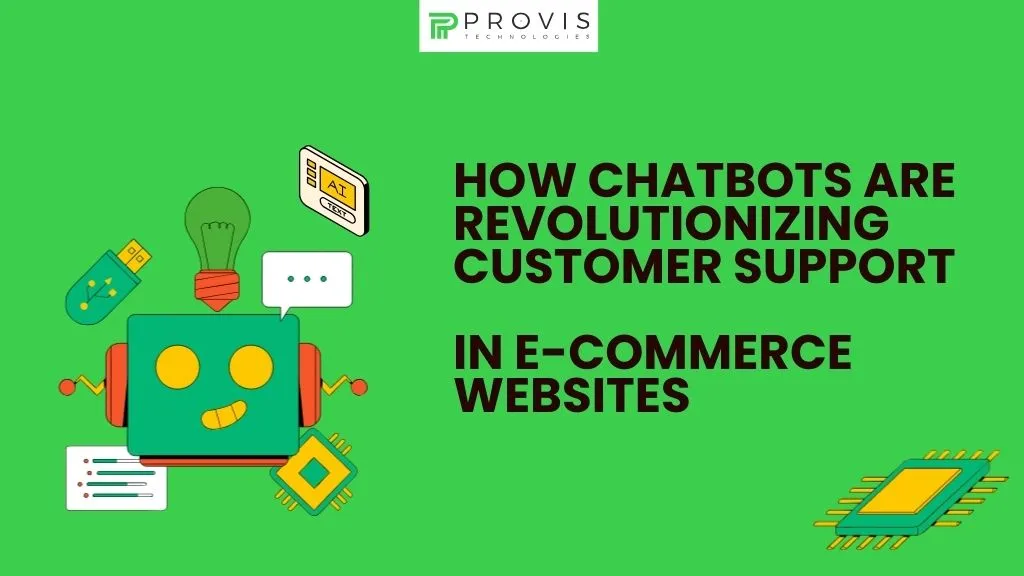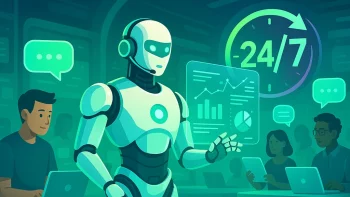How does an e-commerce site ensure the adequate provision of its services 24/7 without incurring losses? Traditional methods still have problems because help doesn’t come quickly when needed, which makes clients unhappy. Here come the chatbots.
These help solve problems that customers have quickly by providing support online that is available 24/7. They help answer basic questions, take orders, suggest products, and provide information that doesn’t need a live person.
Customers like this new way of doing business because it improves service and helps the company save money. Specifically, see how chatbots make customer support better and faster for online shopping companies.
The Role of Chatbots in Modern Customer Support
- Improved Information Gathering: They use chatbots to obtain useful information and feedback from customers, which can be assessed to determine the customers’ interests or usage.
- Convenient Omnichannel Support: They complement any of these channels with those that are not supported by the system, i.e., websites, social media, or messaging applications, to achieve cross-platform support.
- Engagement of Customer: Users, for example, can be targeted, and conversations started with a chatbot based on the chatbot’s view of users. For example, if the users have not proceeded any further, they could be prompted to assist.
- Transfer Techniques: Vice versa, if the clients have requests that surpass the scope of the chat bot’s automation, a real agent can handle them, and the consumers are happy.
- Customer Interaction Completion: Follow up with customers via chatbots and request them to or send them feedback already.
- Effective Support Management: Every organization can offer customer support services in a controlled fashion that corresponds to the growing levels of contacts without employing more staff.
How Exactly do Chatbots work?
Chatbots are computer applications assisted by various technologies and algorithms to perform the likeness of a human conversation and subsequent replies. Here’s a breakdown of how they work:
1. User Input Collection
Most people interacting with a chatbot will enter some text or speak rather than do nothing at all. This first step typically has two parts: sending user queries to the chat bot’s processing center.
2. Natural Language Processing (NLP)
This is essential in any user input. The chatbot employs NLP algorithms to deconstruct text or speech and understand it. It captures vital elements, including the intent, entities, and context.
3. Intent Recognition
When the input has been processed, the chatbot ascertains the user’s intent. This comes after the user enters a query into the system, which is matched with the defined user intent, topics, or intents that the chatbot is designed to recognize.
4. Response Generation
The recognized intent determines the response that is given by the chatbot. The traditional chatbots that employ rules to determine responses would simply employ a script to elicit a response from the stakeholders. The more recent and more advanced chatbots, which are AI-based, generate responses with the aid of machine learning models.
5. Action Execution
For instances when the user does not require any information and would only like the responding robot to carry out certain activities, response robots can undertake actions such as order processing, editing customer accounts, issuing tickets, or making bookings. This helps in enhancing the practicality of chatbots as they link to other backend systems rather than remaining as mere conversational agents.
Don’t Miss:- How Augmented Reality (AR) Is Transforming E-Commerce Websites
Benefits of Chatbots for E-commerce Websites
Nowadays, chatbots have become an integral part of many e-commerce websites. They aid in improving customer service and enhance the performance of the business as a whole.
1. Always available support
Bots offer support 24 hours a day, which means the customer can get help at any time despite the time zone. There are 24 hours of support, which means the business can reach out to an international audience and respond to issues even when ordinary people are not on operational hours.
2. Save Costs
The costs incurred when operating chatbots are low as compared to other forms. Changes in how some questions are answered by the customer care representatives may cut down their numbers. This is a cheaper means of having these resources better deployed.
3. Response time
An important utility of the chatbots is that, once activated, they can provide human-like interaction with a customer instantly. Customers don’t have to nurse their grievances on the phone for more accurate assistance or wait for the email administrators to reply to them. Replies to customers’ issues and concerns and people’s inquiries are immediate, thus improving the users’ overall experience.
4. Quality of service provided is constant
The nature of a chatbot is that it provides the same set of answers to every client because it responds based on written instructions. This consistency helps enhance the customers’ brand image and ensures no change in customer support.
Must Know:- How Progressive Web Apps (PWAs) Are Transforming the E-commerce Landscape?
Types of Chatbots Used in E-commerce
There are different types of chatbots in e-commerce, each providing a different functionality, which is explained further.
1. Rule-Based Chatbots
The rule-based rats follow scripts and decision trees. These rats respond to certain words or phrases and are ideal for executing simple functions and answering routine queries. They answer only the set questions provided in the script, making them very useful for the most basic level of customer support.
2. AI-Powered Chatbots
Compared to the first type, these need no prior programming as they incorporate artificial intelligence and natural language processing to answer a wider range of questions. And unlike others, they adapt to interactions and become better responders than right away. Such technology applications are comparatively more interesting as they engage users’ contact, behaving differently on various topics and giving recommendations based on users’ activities.
3. Hybrid Chatbots
They are a mixture of rule-based and AI-based systems. They follow the steps only for common injections and prescriptive queries because when the situation becomes too complex, special injections are added. This model provides efficient resolutions of routine problems and elevates care in the complexities around customer care services.
Related Blog:- AI in E-commerce Benefits of Artificial Intelligence in E-commerce
Future Trends in Chatbot Technology
Certainly! Here’s a rewrite of the text provided: While there still exists an opportunity to improve the functionality and efficiency of the chatbot technology, the future holds potential for even more self-exciting progress and enhancements. Below are five hypotheses which we posit:
1. Enhanced Capabilities of Artificial Intelligence
In the coming years, chatbots will increasingly be built using advanced artificial intelligence to make chats more human-like and user-friendly. Learning algorithms and machine learning in scope will be easier since the chatbots will have more insights into how help can be offered.
2. Better Natural Language Processing (NLP)
As time passes, NLP technology will further improve, thereby equipping the chatbots with a better understanding of language usage and context boundaries. It is predicted that improved NLP will help in solving ambiguities arising from complex questions, accounting for colloquial language, and helping in handling multiple exchanges in active sessions.
3. Support of Multiple Languages
With the ever-changing dynamics of commerce and globalization, there will be a growing demand for multilingual language support. Chat support will undoubtedly focus on multilingual chatbots, enabling users to interact with them in native languages.
4. Connections with New Generation Technologies
Extent to which the rising trends would eventually alter public and customer relations, particularly amongst businesses and their customers. This is because chatbot systems will also begin adopting rising technologies focusing on augmented reality (AR), virtual reality (VR), and many other technologies where customers will be given simulated experiences.
Don’t Skip :- How to Improve Your Website With Artificial Intelligence?
Conclusion
To conclude, there is nothing left that compares to chatbots when it comes to customizing the focus of the consumers. They conduct analysis and improve the service delivery using the data collected, encourage interactions before and after the consumers even contact them, and do all this with ease across different platforms. Chatbots lower basic service costs and maintain the support that can grow with constant demand by taking over deadweight tasks and active query management.
They can detect escalation points and relevant follow-up actions that satisfy customers and enhance service delivery.
Written By
Author's Picks
- How Do Apps Make Money in 2025? 12 Best Strategies to Follow
- 20/12/2024
- eCommerce Site Speed: The Silent Killer of Sales & How to Fix It Fast!
- 02/04/2025
- 10 Essential Tips for Launching Your E-commerce Journey with WooCommerce
- 08/05/2024
Categories
- AI for Startups
- AI in Web Development
- AI Integration
- AI Platforms
- AI Prompt
- AI Tools
- AI Trading Software
- Android App
- Android vs iOS Development
- Angular
- API
- API Development
- App
- app development
- App Idea
- App User Feedback
- Application
- Artificial Intelligence
- Audit Services
- Automotive Industry
- Awards and Recognition
- Business Consulting
- Business Website
- Chatbots
- CRM
- CRM for Financial Advisors
- Custom CRM
- Custom SaaS
- Custom Website
- Customer Service
- dashboard design
- Developing a Mobile App
- Digital Business
- E-commerce
- EMR Integration
- Finance
- Financial Advisors
- Financial Advisors
- GIT
- Health Insurance
- iOS App
- iOS App Development
- IoT Mobile App Development
- IoT Platforms
- IT Audit Services
- IT Consulting
- IT Strategies
- Java Development
- Laravel
- Lean Canvas
- Learning Management System
- Logistics Apps
- Mobile App Development
- MVP
- Native App
- News Aggregator Site
- OTT
- Outsourcing IT
- Payment Gateway
- predictive analysis
- Product Launch Strategy
- Progressive Web App (PWA)
- Prototype
- Recommender Systems
- Ruby
- SaaS
- SaaS Application
- SaaS Business
- SaaS Company
- SaaS Development
- SaaS Product
- SaaS Project
- Sales Funnel
- SEO
- Shopping Cart
- Software Development
- SSL and TLS
- Startup Checklist
- Technology
- Tetradic Color Scheme
- UI/UX Design Company
- Unit Testing
- User Flow
- User Testing
- Web Development
- Web Performance Optimization
- website Maintenance Services
- Website Migration Service
- Website Speed Optimization
- WooCommerce
- WordPress





